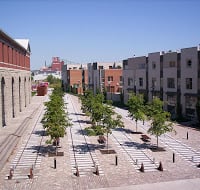Your Supplier for Quality Engineered Soil & Aggregate Binders
Minick Materials understands that builders, civil engineers, contractors, and architects need high-quality solutions to soil-related problems that affect the integrity of their work. We’ve been supplying landscaping and construction professionals with high-quality engineered soils for over 60 years!
Learn how our products, such as the variety of engineered soils we offer, can help reduce stormwater runoff, cracking pavements, damage to plants, and liability due to unsafe walkways.
Minick Materials is a licensed supplier of CU-Structural Soil® and RoofliteⓇ
Whether it’s called manufactured soil or engineered dirt, having the right foundation for your landscaping, construction, or architectural projects is critical. We make sure to supply quality soil solutions, which is why we supply CU-Structural and RoofliteⓇ soil to our customers.
CU Structure Soil Time-lapse in d'Alhousie Square, Canada (2004, 2012, 2018)



Rooflite


CU-Structural Soil®
Rooflite® , Certified Green Roof Media
CU-Structural Soil was developed at Cornell University as a way to safely bear pavement loads after compaction and yet still allow root penetration and vigorous tree growth.
CU-Soil® is intended for paved sites to provide adequate soil volumes for tree roots under pavements. CU-Soil® is an innovative, cost-effective medium installed under pavement that improves street tree vigor and prevents sidewalk failure, frequent pavement repair, virtually eliminates tripping lawsuits, and greatly reduces the replacement of dead trees every 7–10 years.
CU-Structural Soil® was patented and trademarked under the name CU-Soil® to ensure quality control. We’re a licensed seller of this great product. Contact us to see if CU-Soil is the right choice for your project!
RoofliteⓇ soil is a lightweight, absorbent, and easy-to-use growing medium. It is made from recycled materials such as wood chips, bark, and sawdust, and is an excellent alternative to traditional potting mix. Their extensive line of soils was specially designed to be lightweight for green roof projects with over 150 blends, customized by purpose and region, scientifically designed for optimum water retention and drainage, which are vital to ensure plant growth and managing stormwater.
It has a high porosity which makes it ideal for use in hydroponic systems, and its light weight means it is easy to transport and handle. Rooflite soil is also sterile, so you can be sure your plants are free from disease and pests.
If you're looking for a versatile and eco-friendly growing medium, Rooflite soil is an ideal choice.
Cornell CU-Structural Soil Guide
Rooflite Guide
Where To Use Engineered Soil Treatment
There are many places where engineered soil can be used for treatment purposes. Though engineered soil is mostly used for vegetated stormwater collection systems it can be used in areas where there is contaminated soil, groundwater, or surface water. Engineered soil can help anytime you need to solve an ecological or environmental problem, from urban forestry to providing growth and stability in high-traffic areas.
Common applications where engineered soil is used as a treatment include:
- Urban Forestry. This term is used as a collective description for the planting, maintaining, and caring of tree populations in urban environments. As most cities are barren and lack the appropriate soils which contain the nutrients needed to support the growth of trees, engineered soil is a great help.
- Green Roofs and Rooftop Gardens. These are vegetative layers grown on a rooftop providing shade, removing heat from the air, and reducing temperatures of the roof surface and surrounding air.
- Biofiltration stripes and swales. These are shallow depressions with sloped sides that vegetation grows in. They help capture, treat and infiltrate stormwater runoff before it gets downstream.
- Compost Filter Socks. These act like containments for compost filter berms. The sock itself is made from a mesh material that's stuffed with compost and placed against sheet-flow runoff (at an angle) to prevent erosion and hold sediment in place within areas that are being disturbed.
- Blue Roofs. These contain a water collection system that temporarily stores and releases stormwater through their gravel soil filtration system.
- Other types of stormwater management systems including green infrastructure and low-impact design.
- Infiltration islands. These are areas, such as parking lots, for example, fitted with stormwater countermeasures to navigate and reduce stormwater volumes in a way that facilitates natural processes such as infiltration and evapotranspiration.
Benefits of Engineered Soil Treatments
The benefits of engineered soil treatments cannot be understated. These specially designed soils use science to help:
- Reduce runoff volume
- Increase infiltration and evapotranspiration
- Increase drainage
- Decrease soil compaction
- Increase chemical adsorption of nutrients and metals in the soil (useful for green roofs and other similar projects)
- Increase in tree health and lifespan and additionally promote downward root growth
- Reduce sidewalk buckling
Looking for more information? Explore these resources
Engineered soil is not the only way to address concerns with pavement integrity, plant health, and other landscaping issues. In combination with practices like using rain gardens and applying engineered soil repairs or soil stabilization, commercial builders, landscapers, and architects can develop sound, sustainable projects that require less maintenance while supporting high plant productivity. Keep reading to learn more.
Architect and Engineer Resources at Minick Materials
We have a dedicated team to work with landscape architects, architects and engineers that are needing options for specific projects. You can contact our experts to get started.



